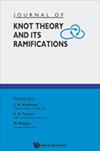n-交叉数的严格不等式
IF 0.4
4区 数学
Q4 MATHEMATICS
引用次数: 0
摘要
2013年,亚当斯引入了结$K$的$n$交叉数,用$c_n(K)$表示。2$-、3$-、4$-和5$-交叉数字之间的不平等现象以前已经确立。我们证明了$c_9(K)\leq c_3(K)-2$对于所有不是平凡结、三叶结或八字形结的结$K$。我们证明了这个不等式是最优的,并获得了以前未知的$c_9(K)$值。我们推广了这个不等式,证明了对于一组特定的结类,$c_{13}(K)Strict Inequalities for the n-crossing Number
In 2013, Adams introduced the $n$-crossing number of a knot $K$, denoted by $c_n(K)$. Inequalities between the $2$-, $3$-, $4$-, and $5$-crossing numbers have been previously established. We prove $c_9(K)\leq c_3(K)-2$ for all knots $K$ that are not the trivial, trefoil, or figure-eight knot. We show this inequality is optimal and obtain previously unknown values of $c_9(K)$. We generalize this inequality to prove that $c_{13}(K)
求助全文
通过发布文献求助,成功后即可免费获取论文全文。
去求助
来源期刊
CiteScore
0.80
自引率
40.00%
发文量
127
审稿时长
4-8 weeks
期刊介绍:
This Journal is intended as a forum for new developments in knot theory, particularly developments that create connections between knot theory and other aspects of mathematics and natural science. Our stance is interdisciplinary due to the nature of the subject. Knot theory as a core mathematical discipline is subject to many forms of generalization (virtual knots and links, higher-dimensional knots, knots and links in other manifolds, non-spherical knots, recursive systems analogous to knotting). Knots live in a wider mathematical framework (classification of three and higher dimensional manifolds, statistical mechanics and quantum theory, quantum groups, combinatorics of Gauss codes, combinatorics, algorithms and computational complexity, category theory and categorification of topological and algebraic structures, algebraic topology, topological quantum field theories).
Papers that will be published include:
-new research in the theory of knots and links, and their applications;
-new research in related fields;
-tutorial and review papers.
With this Journal, we hope to serve well researchers in knot theory and related areas of topology, researchers using knot theory in their work, and scientists interested in becoming informed about current work in the theory of knots and its ramifications.

 求助内容:
求助内容: 应助结果提醒方式:
应助结果提醒方式:


